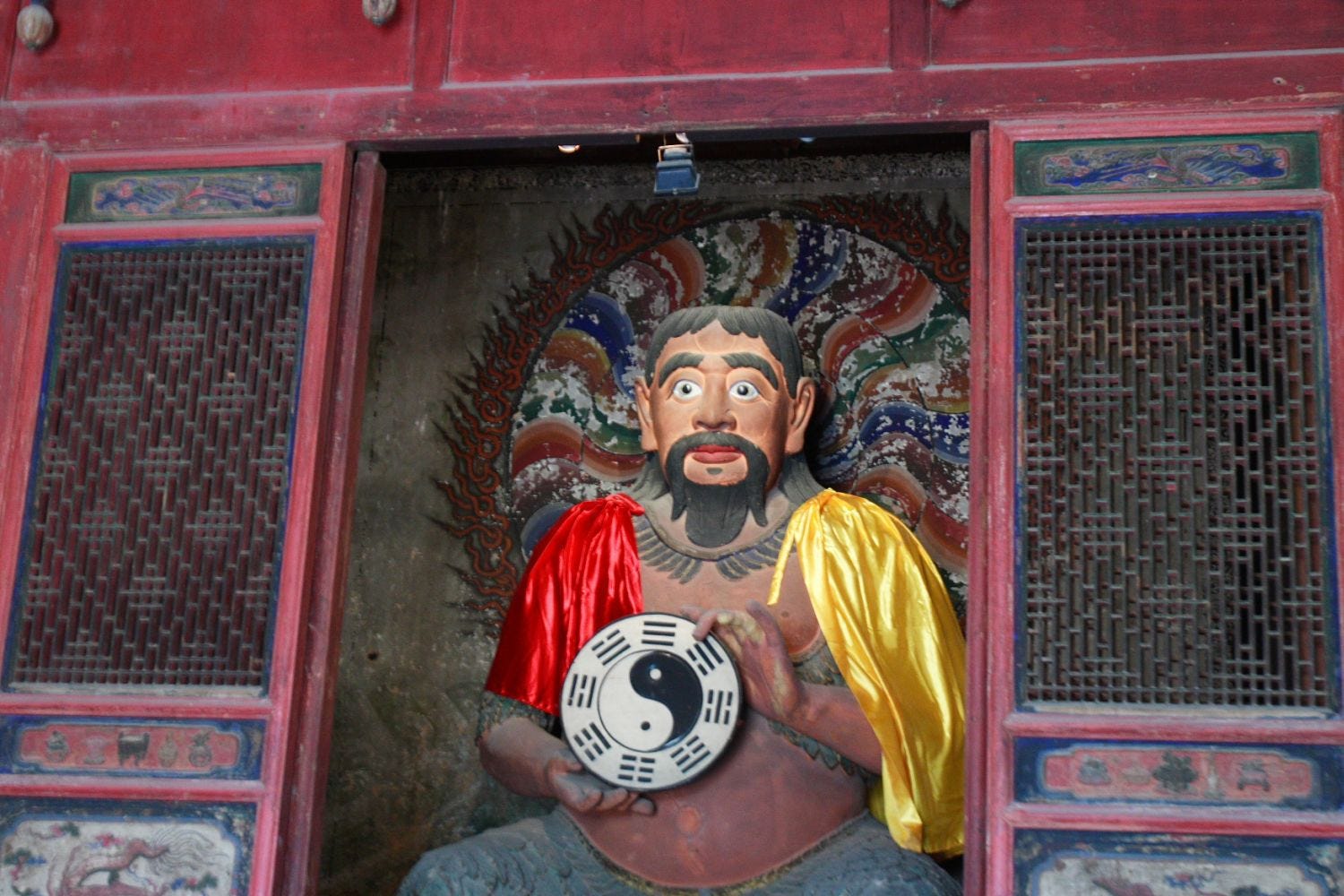
We speak of “moving heaven and Earth” as a metaphor in English for great effort towards a goal. According to Fu Xi’s I Ching, an ancient Chinese divination method, we can metaphorically move heaven and Earth simply by changing our attitude, and in the process, pave the way for peace, success, and happiness. Let’s take a look and see what actionable insight we can gain from this venerable perspective.

Fu Xi
Fu Xi is a legendary Chinese emperor, one of the first three emperors of China. While some theorize that Fu Xi corresponds to an actual person, the legendary Fu Xi had the head of a man and the body of a snake and was the direct creation of Hua Hsu, a god being created by the original creation god Pangu. Fu Xi, in turn, created humanity by helping his sister make people out of clay. Theories place the emergence of Fu Xi around 2,600 B.C. when China began to change from a matriarchal society to a patriarchal society.
In addition to helping his sister create humanity, Fu Xi is credited with teaching people to cook and to hunt and fish with tools. According to legend, he introduced the institution of marriage. He is also credited with inventing writing. And one day, he happened to see a magic river dragon, or perhaps a very big turtle, emerge from the river with intricate patterns on its shell. He realized the patterns were a representation of the eight elemental components of existence. Further pondering led him to conclude that by combining pairs of elements (resulting in 64 possible combinations) he could assess the present and predict the future.

I Ching Hexagrams
A hexagram is a pair of two trigrams — groups of three lines. The lines may be broken, like a pair of dashes, or continuous. Each group of three lines represents a simple, elemental concept. For instance, three unbroken lines represent “Heaven” and three broken lines represent “Earth.” An unbroken line signifies, among other things, masculine energy, or “Yang.” A broken line signifies feminine energy, or “Yin.” Thus “Heaven,” with three unbroken lines is the most Yang element there is, whereas “Earth,” with three broken lines is the most Yin.
The eight elements are:
- Heaven, the Creative
- Lake, the Joyous
- Fire, the Clinging
- Thunder, the Arousing
- Wind, the Gentle
- Water, the Abysmal
- Mountain, Keeping Still
- Earth, the Receptive

Hexagram Eleven
In Hexagram Eleven, the Earth (Yun) is above Heaven (Quian). It is called Tai, which is variously translated as “peace,” “greatness,” or “pervading” in the sense that the power of this mode is pervasive. What does it mean for Earth to be above Heaven?
Heaven is normally above the Earth. Heaven is the creative; Earth is the receptive. When Earth is above Heaven, their energies combine because the energy of Earth sinks and the energy of Heaven rises. This produces the ultimate form of power that combines the masculine and feminine energy of creation and reception perfectly. But that is rather abstract. What does it mean in concrete terms?
Heaven represents our desire to create. Earth represents our willingness to receive. So to put the conditions of Hexagram 11, “Tai,” or “Peace” in the most the simple terms, when we put place our impulse to create as a foundation for our desire to receive, we will find inner peace. It is ok for us to have our individual needs and desires, but we must seek to fulfill them by creating something that is truly valuable for others.
This resonates with the Buddhist concept that wealth without work is unhealthy and the Christian notion that it is service to others (well, God) that gives life meaning. The lessons of Hexagram 11 aligns with Aristotle’s notions about wealth as well.
It certainly makes sense to us. As nice as it is to be wealthy, we think it is hard to be truly happy if you don’t feel that you have made a contribution to the happiness of others.

Join Us As We Explore The Good Life
Who wouldn’t like to live a better life? We are fascinated by the emerging consensus between ancient philosophers and modern scientists — and the actionable insights on how to live a better life that they reveal. Standing on the shoulders of giants, we’ll survey the map of human meaning and fulfillment created by our greatest poets, philosophers, and scientists.
Some of the most compelling contemporary research and insight comes to us from the Ivy League. We’ll tell you all about one of the largest and longest studies of success and happiness ever conducted in our article on the secrets of the Harvard Report. Then we’ll take a look at the most popular course in the history of Yale, Psychology and The Good Life, and tell you how you can take the course for free.
If you are interested in exploring the pragmatic power of meditation and the clarity and creative freedom you can reach by learning to not think, we’ve got an article on what meditation can do for you and another on the scientifically proven benefits of yoga.
We explore the inspiring concept of the value of struggle in The Hero’s Journey here — and then get into its actionable implications in terms of defining a life project and becoming the active hero of your own story. The theme of nuanced and thoughtful examination of the idea of Eudaimonia, the good life, runs through our culture, from ancient Greeks to modern psychologists and economists.
Leaving no stone unturned, we’ll yield the philosopher’s podium to famed economist John Maynard Keynes and let him take a crack at showing us the way to a meaningful life. His thoughts echo those of the ancient Greek proto-economist Aristotle, who agrees with modern economist Kahneman about the relationship between humans and money. These notions are reflected in the myths of Midas and Erysichthon and validated by Easterlin and other modern social scientists.
Setting a course for more abstract topics, we’ll discuss Joseph Campbell’s notion that to live at a mythic scale and shake things up, you have to have so much passion for your project that others might think you are a bit mad. We’ll look into Ph.D./charlatan/shaman Carlos Castaneda’s notion of the struggles of a man of knowledge and Carl Jung’s musings on how to find your true soul.
We’ve also got a more typical luxury travel fare; discover five amazing exclusive beaches in Asia and five restaurants on Bali that we think could be worthy of a Michelin star.
We’ve also got a more typical luxury travel fare; discover five amazing exclusive beaches in Asia and five restaurants on Bali that we think could be worthy of a Michelin star.
Please join us as we continue on our conceptual journey to the heart of the art of the good life. You can follow our articles here on Medium if you have an account, or simply bookmark our Medium page with the complete article list or follow us on Facebook.




No comments:
Post a Comment